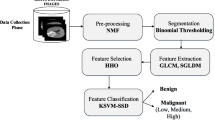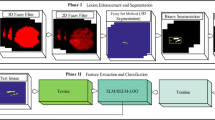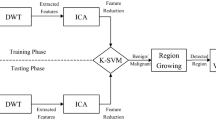Abstract
An uncontrollable growth of abnormal cells in the brain may result in brain tumor. Two different categories of brain tumor are benign and malignant. The doctors need to provide an efficient treatment for tumor affected patients, usually, the treatment process for both the types of tumors are different, as these two types may show diverse properties. Therefore it is necessary to accurately segment and classify the two types of brain tumor from MRI so that the doctors can provide proper treatment to each patient. For such segmentation and classification, a practical approach is introduced in this method. The tumor classification from MRI undergoes 4 different phases they are pre-processing, segmentation, feature extraction, and classification. During pre-processing, the Laplacian of Gaussian (LoG) and Contrast Limited Adaptive Histogram Equalization (CLAHE) is applied. Then, the features from the segmented image is extracted using three different extraction techniques. But sometimes the extracted features may found in large dimension with relevant and irrelevant features. To reduce that, an optimization based feature selection process is included before tumor classification phase. A kernel based Softplus extreme learning machine (KSELM) is used for classification. Finally, the experimental analysis is carried out with BRATS 2014, 2015, 2018, and BRT (Brain tumor) dataset. The performance metrics like accuracy, specificity, PPV, FNR, FPR, DSC, JSI, and sensitivity are determined. Different existing brain tumor classification techniques are compared with this proposed KSELM technique.










Similar content being viewed by others
References
Amin J, Sharif M, Yasmin M, Saba T, Anjum MA, Fernandes SL (2019) A new approach for brain tumor segmentation and classification based on score level fusion using transfer learning. J Med Syst 43(11):326
Bahadure NB, Ray AK and Thethi HP (2017) Image analysis for MRI based brain tumor detection and feature extraction using biologically inspired BWT and SVM. Int J Biomed Imaging 1–12. https://doi.org/10.1155/2017/9749108
Bahadure NB, Ray AK, Thethi HP (2018) Comparative approach of MRI-based brain tumor segmentation and classification using genetic algorithm’. J Digit Imaging 31(4):477–489
Benaichouche AN, Oulhadj H, Siarry P (2013) Improved spatial fuzzy c-means clustering for image segmentation using PSO initialization, Mahalanobis distance and post-segmentation correction. Digit Signal Process 23(5):1390–1400
Chen HL, Wang G, Ma C, Cai ZN, Liu WB, Wang SJ (2016) An efficient hybrid kernel extreme learning machine approach for early diagnosis of Parkinson’s disease. Neurocomputing 184:131–144
Chen S, Yao L, Chen B (2016) A parameterized logarithmic image processing method with Laplacian of Gaussian filtering for lung nodule enhancement in chest radiographs’. Med Biol Eng Comput 54(11):1793–1180
Dey V, Zhang Y, Zhong M (2010) A review on image segmentation techniques with remote sensing perspective. Vienna, Austria: na, 38:31–42
Gao XW, Hui R, Tian Z (2017) Classification of CT brain images based on deep learning networks. Comput Methods Prog Biomed 138:49–56
Havaei M, Davy A, Warde-Farley D, Biard A, Courville A, Bengio Y, Pal C, Jodoin PM, Larochelle H (2017) Brain tumor segmentation with deep neural networks. Med Image Anal 35:18–31
Huang HM, Liu HS, Liu GP (2012) Face recognition using pyramid histogram of oriented gradients and SVM. Adv Inf Sci Serv Sci 4(18):1–8
Iqbal S, Ghani MU, Saba T, Rehman A (2018) Brain tumor segmentation in multi-spectral MRI using convolutional neural networks (CNN). Microsc Res Tech 81(4):419–427
Irum I, Shahid MA, Sharif M, Raza M (2015) A review of image denoising methods. J Eng Sci Technol Rev 8(5):41–48
Kalam R, Thomas C, Rahiman MA (2016) Gaussian Kernel Based Fuzzy Cmeans Clustering Algorithm For Image Segmentation’. Comput Sci Inf Technol 2016:47–56
Kumari N, Saxena S (2018) March. Review of Brain Tumor Segmentation and Classification. In 2018 International Conference on Current Trends towards Converging Technologies (ICCTCT). 1–6. IEEE
Lu S, Lu Z, Yang J, Yang M, Wang S (2018) A pathological brain detection system based on kernel based ELM’. Multimed Tools Appl 77(3):3715–3728
Masood S, Sharif M, Yasmin M, Raza M, Mohsin S (2013) Brain image Compression: A brief survey. Res J Appl Sci Eng Technol 5(1):49–59
Mathew AR, Anto PB, Thara NK (2017) Brain tumor segmentation and classification using DWT, Gabour wavelet and GLCM’. In: 2017 International Conference on Intelligent Computing, Instrumentation and Control Technologies (ICICICT), 1744–1750.
Nakib A, Oulhadj H, Siarry P (2009) A thresholding method based on two-dimensional fractional differentiation. Image Vis Comput 27(9):1343–1357
Özyurt F, Kutlu H, Avci E, Avci D (2018) A new method for classification of images using convolutional neural network based on Dwt-Svd perceptual hash function. In: 2018 3rd International Conference on Computer Science and Engineering (UBMK) IEEE. 410–413
Özyurt F, Sert E, Avci E, Dogantekin E (2019) Brain tumor detection based on Convolutional Neural Network with neutrosophic expert maximum fuzzy sure entropy. Measurement 147:106830
Raju AR, Suresh P, Rao RR (2018) Bayesian HCS-based multi-SVNN: A classification approach for brain tumor segmentation and classification using Bayesian fuzzy clustering’. Biocybern Biomed Eng 38(3):646–660
Sharif M, Tanvir U, Munir EU, Khan MA, Yasmin M (2018) Brain tumor segmentation and classification by improved binomial thresholding and multi-features selection. J Ambient Intell Humanized Comput 1–20
Sharif M, Amin J, Raza M, Anjum MA, Afzal H, Shad SA (2020) Brain tumor detection based on extreme learning. Neural Comput Appl 32:1–13. https://doi.org/10.1007/s00521-019-04679-8
Shree NV, Kumar TNR (2018) Identification and classification of brain tumor MRI images with feature extraction using DWT and probabilistic neural network. Brain Inf 5(1):23–30
Singh NP, Dixit S, Akshaya AS and Khodanpur BI (2017) Gradient Magnitude Based Watershed Segmentation for Brain Tumor Segmentation and Classification. In: Proceedings of the 5th International Conference on Frontiers in Intelligent Computing: Theory and Applications, Springer, Singapore. 611–619
Song B, Chou CR, Chen X, Huang A, Liu MC (2016) Anatomy-guided brain tumor segmentation and classification. In: International Workshop on Brainlesion: Glioma, Multiple Sclerosis, Stroke and Traumatic Brain Injuries. Springer, Cham. 162–170
Sutojo T, Tirajani PS, Sari CA, Rachmawanto EH (2017) ‘CBIR for classification of cow types using GLCM and color features extraction. In: 2017 2nd International conferences on Information Technology, Information Systems and Electrical Engineering (ICITISEE) IEEE. 182–187
Tahir B, Iqbal S, Usman Ghani Khan M, Saba T, Mehmood Z, Anjum A, Mahmood T (2019) Feature enhancement framework for brain tumor segmentation and classification. Microsc Res Tech 82(6):803–811
Thajeel SAN, Sulong G (2015) A novel approach for detection of copy move forgery using completed robust local binary pattern. J Inf Hiding Multimed Signal Process 6(2):351–364
Tharwat A, Gabel T (2019) Parameters optimization of support vector machines for imbalanced data using social ski driver algorithm. Neural Comput Appl 32:1–14
Tiwari A, Srivastava S, Pant M (2020) Brain Tumor Segmentation and Classification from Magnetic Resonance Images: Review of selected methods from 2014 to 2019. Pattern Recogn Lett 131:244–260
Usman K, Rajpoot K (2017) Brain tumor classification from multi-modality MRI using wavelets and machine learning. Pattern Anal Applic 20(3):871–881
Yadav G, Maheshwari S, Agarwal A (2014) Contrast limited adaptive histogram equalization based enhancement for real time video system. In: 2014 International Conference on Advances in Computing, Communications and Informatics (ICACCI) IEEE. 2392–2397
Author information
Authors and Affiliations
Corresponding author
Additional information
Publisher’s note
Springer Nature remains neutral with regard to jurisdictional claims in published maps and institutional affiliations.
Rights and permissions
About this article
Cite this article
Sasank, V.V.S., Venkateswarlu, S. Brain tumor classification using modified kernel based softplus extreme learning machine. Multimed Tools Appl 80, 13513–13534 (2021). https://doi.org/10.1007/s11042-020-10423-5
Received:
Revised:
Accepted:
Published:
Issue Date:
DOI: https://doi.org/10.1007/s11042-020-10423-5




